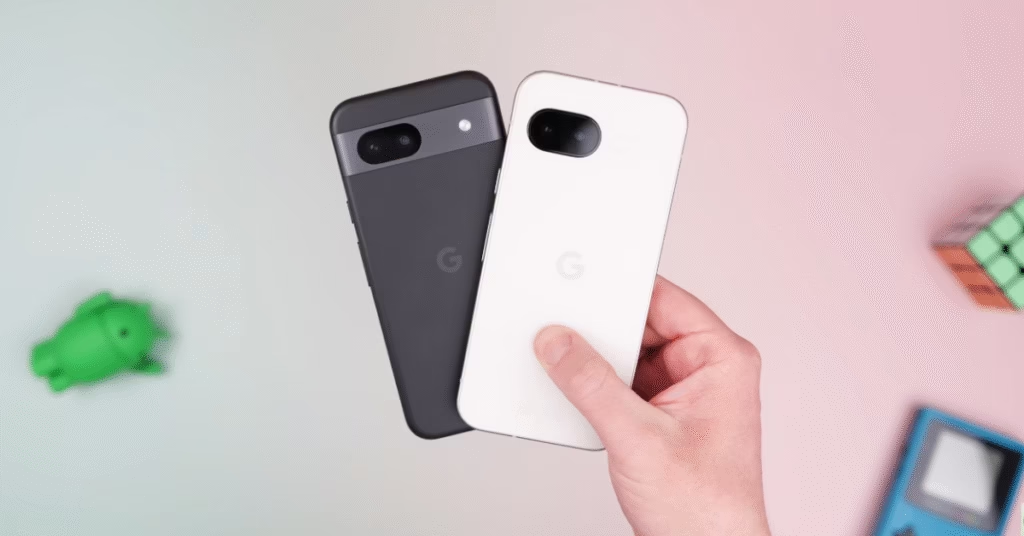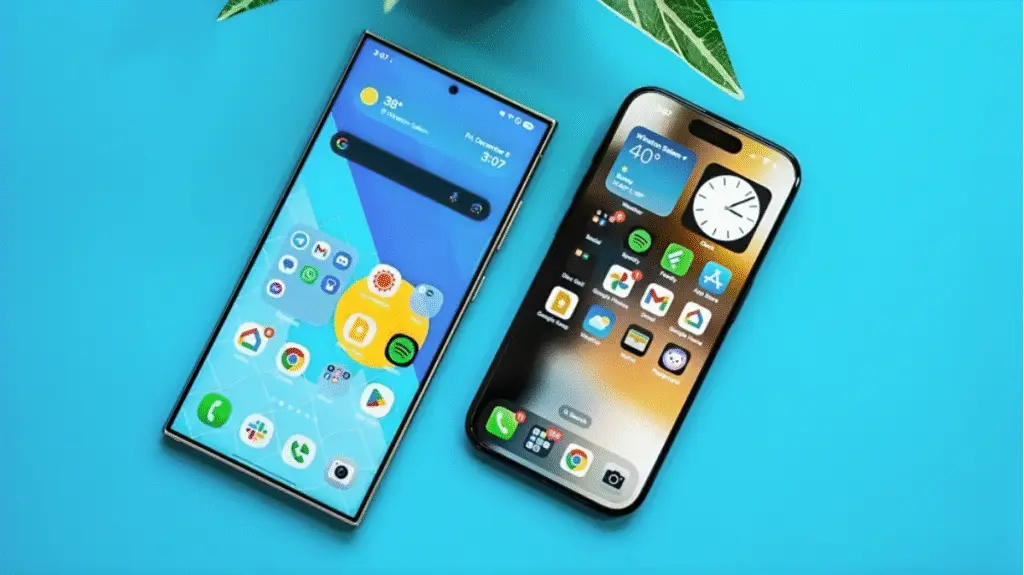
When Google launched the Pixel 8a last year, it quickly became one of the most interesting mid-range phones. It packed strong performance, great software support, and that signature Pixel camera quality, all at a price lower than the flagship models. But as much as I liked the 8a, it always felt like it sat a little too close to the regular Pixel 8, missing just enough features to feel out of place.
Fast forward to this year, and we now have the Pixel 9a. I’ve been using it for about a week, and I can confidently say that Google has finally shifted the A-series in a direction that feels more distinct. The changes aren’t massive at first glance, but once you use it daily, you start to notice where it pulls ahead and where it still feels familiar.
Design and Build: Sharper, Flatter, and More Modern
One of the biggest differences you’ll notice right away is the design. The Pixel 8a had those softer curves and a bubbly look that matched the Pixel 8 series. It was nice, but it didn’t really stand out. The Pixel 9a, however, has gone for a flatter, sharper design that lines up with the Pixel 9 family.
To me, it looks more modern and a bit less playful. The uniform bezels are a little thick, which some people may not love, but I actually like the balanced look. The good news is that the 9a now has an IP68 rating first for the A-series. That means you can confidently use it in dustier or wetter environments without worry.
Despite being slightly larger with a 6.3-inch display, it’s lighter than the Pixel 8a. That’s something I appreciated while carrying it around during the week; it feels substantial but not heavy.
Quick Comparison
| Specification | Pixel 8a | Pixel 9a |
|---|---|---|
| Display | 6.1″ OLED, FHD+, 120Hz | 6.3″ P-OLED, FHD+, 120Hz, brighter |
| Chipset | Tensor G3 | Tensor G4 (improved cooling) |
| RAM | 8GB | 8GB |
| Storage | 128GB, 256GB | 128GB, 256GB |
| Main Camera | 64MP + 13MP ultra-wide | 48MP (new sensor) + 13MP ultra-wide |
| Front Camera | 13MP | 13MP |
| Battery | 4,492mAh, 18W charging | 5,100mAh, 23W charging |
| Wireless Charging | 7.5W | 7.5W |
| Software Support | 7 years (until 2031) | 7 years (until 2032) |
| IP Rating | IP67 | IP68 |
| Launch Price | $ 245.00 / € 304.00 / £ 299.95 | $ 399.99 / € 426.50 / £ 449.00 |
Display: Brightness Makes the Difference
The Pixel 8a already had a solid screen for its price, but the Pixel 9a takes it further. With its new panel, you get more brightness, which makes a big difference outdoors. I tested both phones side by side in direct sunlight, and the 9a clearly had the upper hand.
At 120Hz, both phones feel smooth when scrolling or gaming, but the extra brightness and slightly larger screen on the 9a make it more enjoyable for media and day-to-day use. Honestly, the 8a still holds its ground well, but once you use the 9a’s display, it’s hard to go back.
Performance and Software: Mostly Familiar, With a Few AI Extras
Both phones are powered by the Tensor G3 chip with 8GB RAM, so performance is nearly identical. Multitasking, gaming, and everyday use are all smooth and reliable on both. However, Google’s big push with AI features is where the 9a starts to separate itself.
With the Pixel 9a, you get access to things like Gemini Nano XXS and exclusive apps such as Pixel Studio and Reimagine for image editing. These aren’t life-changing, but they add extra value if you’re into experimenting with photos and AI tools. The Pixel 8a misses out on some of these, likely because of software limitations.
That said, the overall Android 15 experience is the same on both phones, and both are guaranteed 7 years of updates. The only difference is that the 9a gets an extra year compared to the 8a, which is something to consider if you plan on keeping your phone for the long haul.
Battery and Charging: A Clear Winner
Battery life is one area where the Pixel 9a really surprised me. It packs a 5100mAh battery, compared to the Pixel 8a’s 4600mAh. That’s almost a 600mAh jump, and you can feel it in daily use.
With the 9a, I could comfortably get through a day and a half without charging, even with heavy social media, camera use, and some gaming. The 8a was solid, but it never lasted quite as long for me.
Charging speeds are also better on the 9a. It supports 23W wired charging, while the 8a is stuck at 18W. Wireless charging remains the same at 7.5W, which is still pretty slow, but at least you have the option.
Camera: Familiar Yet Slightly Sharper
Now, let’s talk camerasarguably the main reason people buy a Pixel. On paper, the Pixel 8a actually has a higher-resolution main sensor at 64MP compared to the Pixel 9a’s 48MP. But specs don’t tell the full story.
In real-world use, the 9a produces sharper photos with better dynamic range. I noticed this especially in outdoor shots where the highlights were more controlled and colors looked slightly cooler but more natural. Both phones share the same ultrawide and selfie cameras, so those shots come out almost identical.
The 9a does get a few extras, though, like auto macro focus for close-up shots and “Add Me” mode for better group photos. They’re small touches, but they give the newer phone a little edge in versatility.
Daily Experience: More Similar Than Different
If I had to sum up the daily experience, I’d say both phones feel almost identical when it comes to basic use. Texting, calls, social apps, and even gaming don’t really show a noticeable gap between the two.
The real differences appear in the design, display brightness, battery life, and those AI extras. If you’re coming from an older A-series model like the Pixel 6a or 7a, the 9a feels like a massive upgrade. But if you already own the Pixel 8a, I honestly wouldn’t recommend upgrading.
Pricing and Value
This is where things get interesting. The Pixel 8a launched at $499, just $100 cheaper than the Pixel 8, which made it harder to recommend at full price. The Pixel 9a is expected to be around the same range, but the improvements like the bigger battery, brighter screen, and IP68 rating make it feel more worth it this time.
That said, if you can find the 8a at a heavy discount (say under $300), it’s still a fantastic buy with years of software updates ahead. But if you want the most future-proof mid-range Pixel, the 9a is the one to get.
Final Verdict
After a week with the Pixel 9a, I feel Google has finally given the A-series its own identity. It’s no longer just a slightly stripped-down version of the flagship; it feels like a balanced, reliable mid-ranger that stands on its own.
The Pixel 8a is still a strong option, especially if you get it cheaper, but the 9a edges it out with better design, display, battery, and a sprinkle of extra AI features.
So, Pixel 8a vs 9a? If you already own the 8a, stick with itit’s still supported for years. But if you’re coming from an older Pixel or looking to buy fresh, the Pixel 9a is the smarter choice.
See Also OnePlus 13 vs Pixel 10 Pro: A Real User Review
FAQs
Is the Pixel 9a a big upgrade over the Pixel 8a?
Not a huge leap, but it does bring a refreshed design, a larger and brighter display, better battery life, and some camera improvements. If you already have the Pixel 8a, it may not be worth upgrading just yet.
Which phone has better battery life?
The Pixel 9a wins here. Its 5,100 mAh battery is larger than the 8a’s 4,600 mAh, and the more efficient hardware gives it a noticeable edge in daily use.
How do the cameras compare between Pixel 8a and 9a?
The Pixel 8a has a higher megapixel main sensor, but the Pixel 9a delivers sharper shots with improved dynamic range and extra features like auto macro focus. Both still offer the typical Pixel photography experience.
What about software updates?
Both phones get seven years of updates, but the Pixel 9a has an extra year on top since it’s a newer release. That means it will stay supported slightly longer.
Should I upgrade from Pixel 8a to 9a?
If your 8a is still running fine, you don’t need to rush. The 9a is a solid phone, especially for new buyers or those coming from older Pixels, but it’s not a must-have upgrade for recent owners.
